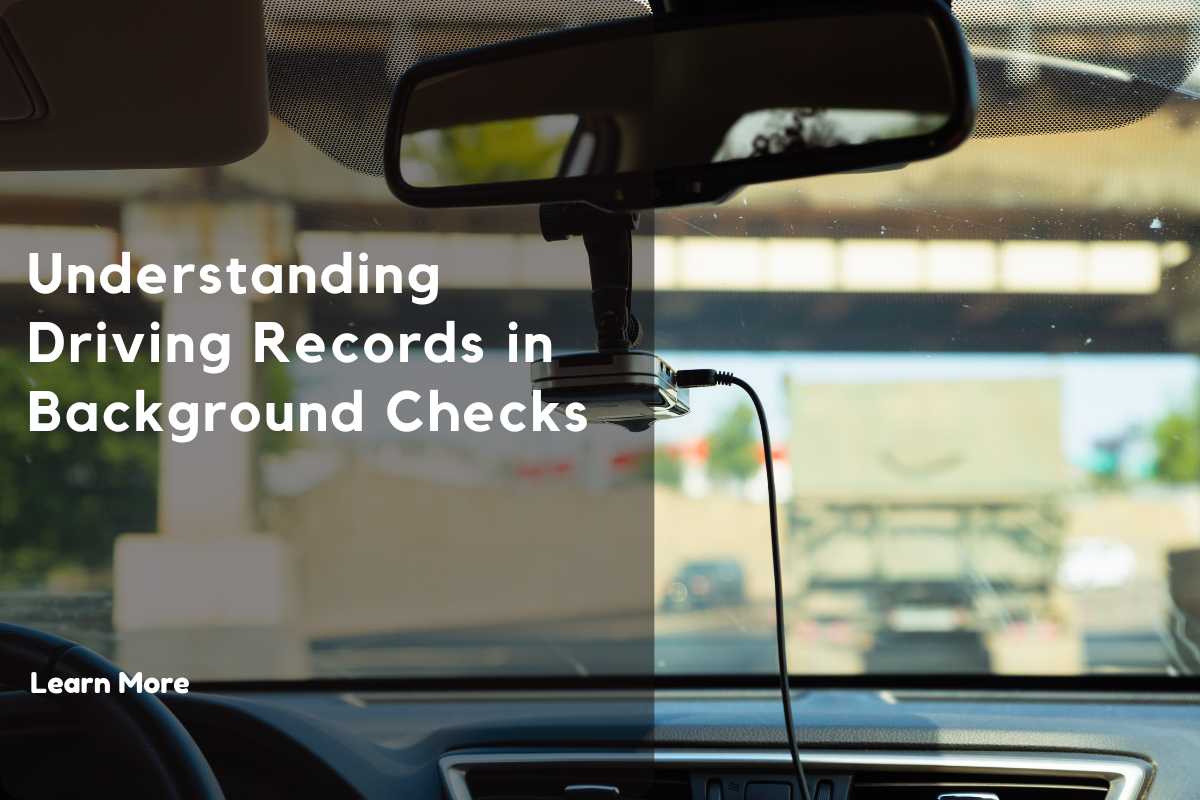
What is a Driving Record?
A driving record, often referred to as a motor vehicle report (MVR), is a document that provides a detailed history of a person’s driving behavior. This record typically includes information on traffic violations, accidents, license status, points on the license, and other driving-related activities. It serves as a snapshot of how responsibly someone drives over time, which is critical information for employers who require employees to drive as part of their job.
Driving records are not limited to information about driving offenses but also include positive aspects, such as clean driving behavior, safe driving courses, and the duration of the license held. In many cases, employers or organizations seeking to assess the risk and suitability of an individual for a driving-related position will rely on this official record to guide their decisions.
Why Are Driving Records Included in Background Checks?
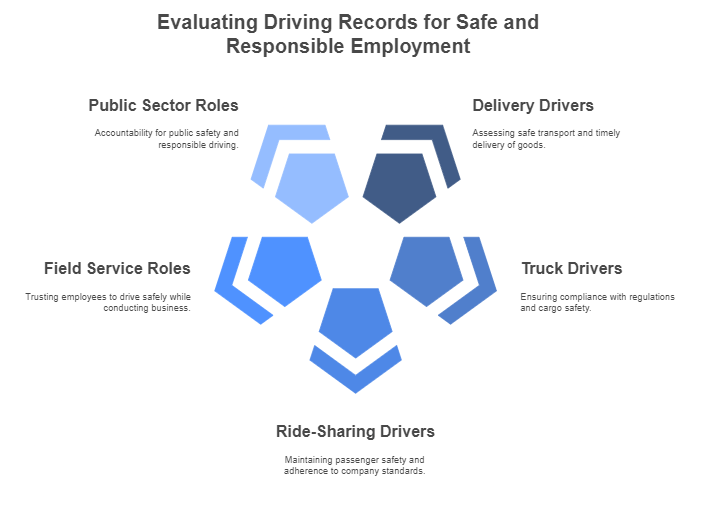
Driving records are an essential part of the background check process, particularly for employers who hire individuals for roles that require vehicle operation. Including driving records in background checks helps employers evaluate the potential risks of hiring a candidate and determine their ability to perform job-related duties while adhering to safety standards and regulations.
For roles that involve driving, the risk of accidents or traffic violations can have significant consequences, both for the individual and the employer. A driving record helps employers ensure that the person they are hiring has a history of responsible driving behavior, reducing the likelihood of incidents, accidents, and legal liabilities.
Driving records provide insight into a candidate’s driving history, including any past infractions that could indicate behavior that might be problematic on the road. It also allows employers to identify potential red flags, such as frequent accidents, DUIs, or suspended licenses, which could disqualify a candidate from certain driving-related positions.
The Importance of Driving Records for Various Job Roles
Certain job roles require driving as a critical part of the job function. For these positions, a clean and reliable driving record is essential. Here are some specific examples of professions where driving records are heavily scrutinized:
- Delivery and Logistics Drivers
Companies in the delivery and logistics sector, such as FedEx, UPS, and local courier services, rely heavily on their drivers’ ability to safely transport goods. A driving record helps assess whether the individual can be trusted to handle company vehicles and deliver products in a timely and safe manner. Poor driving behavior, such as multiple accidents or citations, could be a red flag that the individual might not be suitable for the role. - Truck Drivers and Commercial Vehicle Operators
Truck drivers who operate large vehicles, including semi-trucks and freight carriers, are often subject to strict regulations from the Federal Motor Carrier Safety Administration (FMCSA). A clean driving record is necessary for maintaining a valid commercial driver’s license (CDL). Additionally, employers in this sector look for individuals with excellent driving records to ensure the safety of the cargo, vehicle, and public on the roads. - Ride-Sharing Drivers
Companies like Uber, Lyft, and other ride-sharing platforms require that their drivers maintain a certain standard of driving. Ride-sharing drivers must have an up-to-date driving record to ensure passenger safety and comply with company regulations. These platforms often have specific guidelines on what constitutes an acceptable driving record, including restrictions on DUIs, speeding tickets, or accidents. - Field Service Representatives and Salespeople
For employees who drive frequently for business, such as sales representatives or field service technicians, driving records are crucial to ensure that they can perform their duties without endangering themselves, the public, or the company’s reputation. A reliable driving history reflects that the employee can be trusted to manage their driving responsibilities while conducting business on the road. - Public Sector Roles (e.g., Emergency Responders, School Bus Drivers)
Public safety positions such as emergency responders, school bus drivers, and municipal employees who drive public service vehicles often undergo rigorous background checks, including the review of driving records. These positions demand individuals who not only drive safely but are also accountable for public safety. A clean driving record demonstrates an individual’s ability to handle the demands of these roles with the utmost responsibility.
Key Information Found in a Driving Record
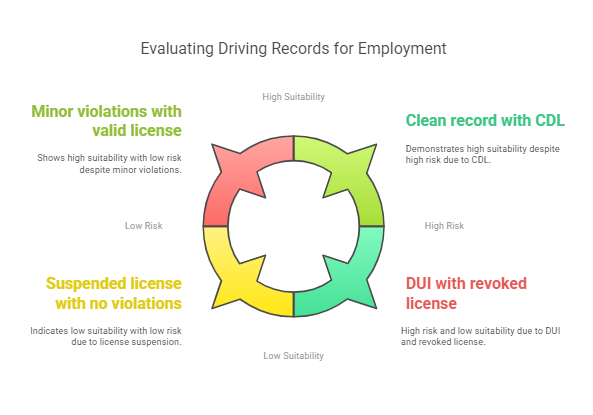
Driving records include a range of information that helps employers assess a candidate’s suitability for a position that requires driving. Some of the most important components of a driving record include:
- Traffic Violations
Traffic violations listed on a driving record include a variety of infractions such as speeding tickets, running red lights, illegal parking, reckless driving, and driving under the influence (DUI). These violations can provide insight into the individual’s driving behavior. More serious infractions, such as DUI or reckless driving, can raise serious concerns about the safety of the driver and others on the road. - Accidents and Collisions
If a driver has been involved in accidents, this will typically be noted on their driving record. Employers may look for patterns of accidents, especially if the candidate was at fault in the majority of them. While accidents are not always preventable, a history of multiple accidents may indicate that the driver is prone to risky behavior, which could be detrimental to the employer’s interests. - License Status
The license status of an individual provides critical information regarding their ability to legally drive. A valid driver’s license is a requirement for many driving-related jobs. Employers will be particularly interested in whether the candidate’s license is active, suspended, or revoked. Suspensions or revocations may occur due to serious traffic violations, unpaid fines, or other legal issues. If the candidate’s license is not in good standing, this could disqualify them from being considered for certain driving roles. - Points on the License
Many states utilize a points system to track traffic violations. For example, if a driver receives a speeding ticket, they may accumulate points on their record. When a driver accumulates too many points, their license may be suspended or revoked. Employers reviewing a driving record will assess the number of points to understand the individual’s driving history and potential risk. - License Classifications
In some cases, driving records will also show what type of driver’s license the individual holds. For example, a commercial driver’s license (CDL) is required for those operating large vehicles like trucks or buses. An individual’s driving record can help employers determine whether the candidate holds the appropriate type of license for the job and if they meet any regulatory requirements.
The Impact of a Poor Driving Record
A poor driving record can have significant consequences for both the candidate and the employer. For candidates, a history of multiple violations or accidents may make it difficult to secure jobs that require driving. It may also lead to higher insurance premiums for employers, as insurers may view the driver as a higher risk.
For employers, hiring individuals with poor driving records can lead to liability issues, increased costs, and potential harm to the company’s reputation. Additionally, a poor driving record can result in higher operational costs due to increased insurance premiums, legal expenses, and vehicle maintenance.
How to Conduct a Background Check with a Driving Record
Conducting a background check that includes a driving record is a crucial step for many employers, especially those whose employees will be operating vehicles as part of their job duties. A driving record provides important insights into a candidate’s driving habits, including their history of traffic violations, accidents, and any possible risk factors. Understanding how to properly conduct a background check that includes a driving record is vital for making informed, responsible hiring decisions.
In this section, we will cover the step-by-step process of conducting a background check with a driving record, what to consider during the process, and why using professional services like Rapid Hire Solutions can be beneficial in ensuring a thorough and compliant check.
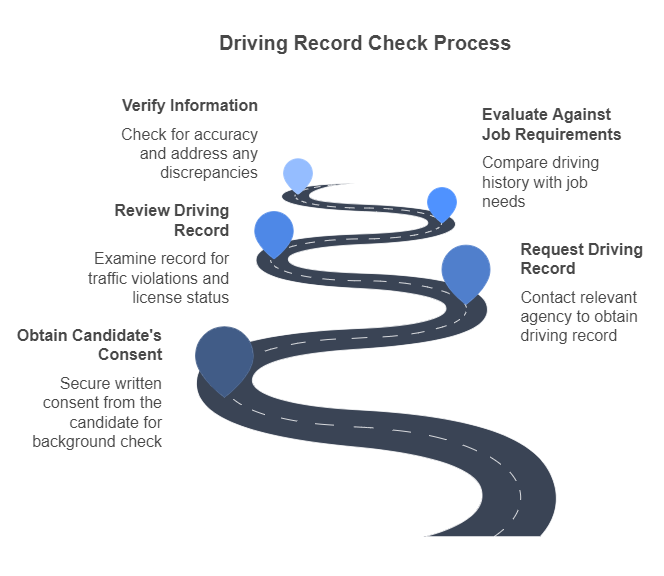
Step-by-Step Guide to Conducting a Background Check with a Driving Record
Step 1: Obtain the Candidate’s Consent
Before conducting any background check, including a driving record check, it is essential to obtain written consent from the candidate. This is required by law in many jurisdictions, especially under the Fair Credit Reporting Act (FCRA), which regulates how employers can access and use background information.
Consent is typically obtained by having the candidate sign a release form that allows the employer to conduct a background check. The form should clearly state that the background check will include a driving record, and the candidate should be informed of what will be checked and why it is necessary for the job.
Step 2: Request the Driving Record from the Appropriate Agency
Once consent has been obtained, the next step is to request the candidate’s driving record from the relevant agency. Driving records are generally available through the Department of Motor Vehicles (DMV) or the equivalent motor vehicle agency in the candidate’s state of residence.
The process for obtaining a driving record may vary depending on the state or country, but generally, employers can request driving records online, by mail, or in person. Some states provide instant online access to driving records, while others may require more time for processing. It’s important to ensure that the request is made to the correct agency and that it is up to date.
In some cases, employers may choose to use a third-party service that specializes in obtaining driving records and conducting background checks. This can streamline the process, particularly when requesting driving records from multiple states or jurisdictions.
Step 3: Review the Driving Record for Relevant Information
Once the driving record is received, the next step is to carefully review the information it contains. Key elements to look for in the driving record include:
- Traffic Violations and Citations: Review the history of traffic violations, including speeding tickets, seatbelt violations, running red lights, or driving under the influence (DUI). Multiple offenses or serious violations, like DUIs, can disqualify candidates for positions that involve driving.
- Accidents and Collisions: Check for any accidents that may be listed on the driving record. Determine whether the candidate was at fault in any of these accidents. If the individual has been involved in multiple accidents, this may be an indication of risky driving behavior.
- License Status: Ensure that the candidate’s license is active and valid. If the individual has a suspended or revoked license, they may not be eligible for jobs that require driving. Additionally, some employers may want to verify whether the license is subject to any restrictions.
- Points on the License: Many states use a points system to track driving violations. Accumulating too many points could lead to a suspension of the driver’s license. Pay attention to the number of points accumulated, as this can affect the individual’s driving eligibility.
- Endorsements or Restrictions: Check if there are any special endorsements on the driver’s license, such as a CDL (Commercial Driver’s License) or restrictions like the requirement to wear glasses while driving. This is particularly important for positions that require specific driving qualifications.
Step 4: Evaluate the Driving Record Against the Job Requirements
Not all driving records are equal, and not all violations will be disqualifying for every position. When reviewing the driving record, it’s essential to evaluate the individual’s driving history in relation to the specific job requirements.
For example, if the position involves occasional driving and light vehicle use, a minor traffic violation might not be a major concern. However, if the role requires frequent driving of company vehicles or commercial vehicles, a serious violation like a DUI could be a significant red flag.
Employers should establish a clear set of criteria for evaluating driving records based on the specific job responsibilities. For instance, if an applicant is applying for a delivery driver position, a history of speeding tickets might be less of an issue compared to a history of reckless driving. Having a consistent set of criteria for evaluating driving records ensures fairness and minimizes legal risks.
Step 5: Verify Information and Address Inaccuracies
While driving records provide a detailed history of a candidate’s driving habits, they are not always 100% accurate. In some cases, the information on a driving record may be outdated, incomplete, or contain errors. If you notice any discrepancies, it is important to verify the information before making a final decision.
If you discover an error on the candidate’s driving record, you should give them the opportunity to explain or dispute the information. They may have proof that a violation or accident was wrongly attributed to them, or they may have successfully resolved an issue that is still listed as pending.
Employers should follow up with the relevant motor vehicle agency to correct any inaccuracies. Ensuring that the driving record is accurate helps to avoid unjustly disqualifying a candidate and ensures that the hiring decision is based on reliable information.
Why Use Professional Services for Conducting Driving Record Checks?
While employers can certainly conduct driving record checks themselves, there are several benefits to using professional services like Rapid Hire Solutions for conducting background checks, including driving records.
- Efficiency and Accuracy: Professional services have established systems in place to obtain driving records from the appropriate agencies quickly and efficiently. They ensure that the information is up-to-date and accurate, helping to avoid any potential delays or inaccuracies in the background check process.
- Comprehensive Check Across States: For companies that operate in multiple states, a professional service can access driving records from various state agencies and provide a comprehensive report. This is particularly valuable for companies that hire drivers from across the country or for positions that require employees to travel across state lines.
- Legal Compliance: The process of obtaining and using a driving record in the hiring process must comply with legal regulations, including the Fair Credit Reporting Act (FCRA) and state-specific privacy laws. Professional background check services are knowledgeable about these regulations and ensure that the process is conducted in a legally compliant manner, protecting both the employer and the candidate.
- Expert Evaluation of Driving Records: Many professional background check services, including Rapid Hire Solutions, have experts who can help employers interpret driving records. They can provide insights on the significance of various violations and help determine how a candidate’s driving history aligns with the requirements of the job.
- Confidentiality and Security: Professional services are equipped to handle sensitive personal information securely, ensuring that the candidate’s driving record and other details are protected. This is particularly important to prevent any unauthorized access to the individual’s private data and to comply with data protection laws.
Key Points to Consider When Conducting Background Checks with Driving Records
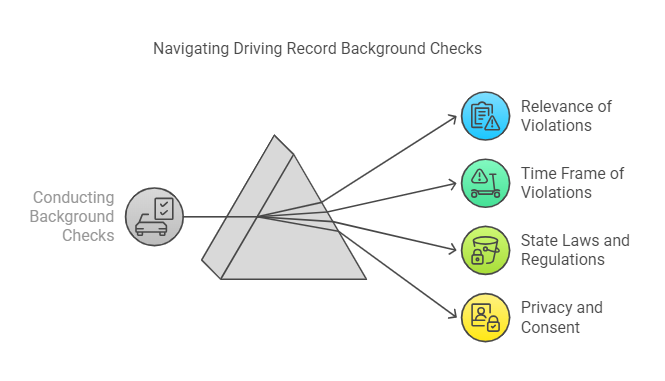
- Relevance of Violations: Not all violations are equally important. It’s essential to consider the severity of the violation and its relevance to the position. A minor speeding ticket may not be as concerning as a history of reckless driving or DUI offenses.
- Time Frame of Violations: Employers should consider the time frame of any violations. A violation that occurred several years ago may not be as relevant as a recent infraction. Some employers may choose to give more weight to recent violations, especially for positions requiring consistent driving.
- State Laws and Regulations: Different states have varying laws and regulations regarding driving records, including what can be included in a driving record and how far back violations can appear. Employers should be familiar with the laws in the candidate’s state of residence.
- Privacy and Consent: Always ensure that the candidate has provided written consent to the background check and understands that their driving record will be reviewed. This is critical for complying with privacy laws and respecting the candidate’s rights.
